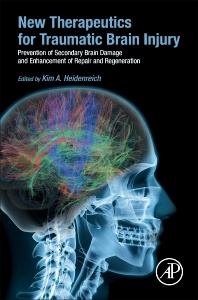Description
New Therapeutics for Traumatic Brain Injury
Prevention of Secondary Brain Damage and Enhancement of Repair and Regeneration
Coordinator: Heidenreich Kim
Language: English
Subjects for New Therapeutics for Traumatic Brain Injury:
Keywords
4-Hydroxynonenal; 5-Lipoxygenase; 7; 8-Dihydroxyflavone; Acrolein; Adrenergic blockade; Allometric scaling; Angiogenesis; Antagonists; Apoptosis; Atmosphere (ata)Depression; Atorvastatin; Attention; Autonomic dysfunction; BDNF; Bipolar disorder; Brain injury; Carbonyl scavenging; Ceftriaxone; Cerebrospinal venous system; Cerebrovascular reactivity; Cholinesterase inhibitors; Clonidine; Cognition; Cognitive impairment; Craniocerebral trauma; Critically ill; Depressive disorders; Dysautonomia; Erythropoietin; Estradiol; Estrogen; Etanercept; Ethinyl estradiol-3-sulfate; Excitotoxicity; FLAP inhibitor; Glasgow Coma scale (GCS)Hyperbaric; Glia; Glibenclamide; Glutamate excitotoxicity; Glutamate transport; Golden hour; Hemorrhage; HMG CoA reductase; Hyperbaric oxygen therapy (HBOT)Injury; Hypomania; Hypothermia; Inflammation; Intracerebral hemorrhage; Intracranial pressure; Ischemia; Lateral fluid percussion; Leukotrienes; Lipid peroxidation; Lipidomics; Magnetic resonance imaging (MRI)Morris Water Maze; Mania; Manic disorders; Memantine; Membrane characteristics; Memory; Mood disorders; Myopathy; Neurogenesis; Neuroinflammation; Neuronal degeneration; Neuroprotection; Neuropsychiatric; Nitric oxide synthase; Nitric oxide; NMDA; NO Synthase inhibition; Oxidative stress; Oxygen; Paroxysmal sympathetic hyperactivity; Perispinal; Pharmacotherapy; Phenelzine; Posttraumatic epilepsy; Pressurized; Progenitor cells; Progesterone; Propranolol; ProTECT III; PSH; Psychotherapy; PUFAs; Regional cerebral blood flow (rCBF)SPECT; Risk factors; Rivastigmine; Secondary injury; Small peptide antagonists; Statin; Sulfonylurea; Supersaturation; Sympathetic storm; SyNAPSe; Synaptic function; TBI; Tetrahydrobiopterin; Therapy; TNF; Trauma; Traumatic brain injury (TBI)Traumatic brain injury; Tropomyosin-related kinase B (TrkB) receptor; Tumor necrosis factor; Voltage-gated calcium channels
352 p. · 15x22.8 cm · Hardback
Description
/li>Contents
/li>Biography
/li>Comment
/li>
New Therapeutics for Traumatic Brain Injury: Prevention of Secondary Brain Damage and Enhancement of Repair and Regeneration explores traumatic brain injury (TBI), a major cause of death and disability throughout the world. The delayed nature of the secondary injury phase suggests that there is a therapeutic window for pharmacological interventions or other approaches to prevent progressive tissue damage and improve functional outcomes. It is now apparent that therapeutic interventions should entail both protective and repair/regeneration strategies depending on the phase of brain injury.
This book describes emerging experimental strategies for the treatment of TBI, including new anti-inflammatory or anti-apoptotic therapeutics that limit brain damage, and novel or repurposed drugs that enhance repair or regeneration of the brain after injury.
Part I. Interventional Therapies for TBI Previously or Currently in Phase 3 Clinical Trials 1. Why Did the Phase III Clinical Trials for Progesterone in TBI Fail? An Analysis of Three Potentially Critical Factors 2. Hypothermia for Traumatic Brain Injury: Current Evidence and Future Directions 3. The Future of TBI: Hyperbaric Oxygen as a Primary Therapeutic Approach
Part II. Repurposing FDA Approved Drugs for TBI Treatment 4. Erythropoietin and Its Derivatives: Mechanisms of Neuroprotection and Challenges in Clinical Translation 5. Atorvastatin in the Treatment of Traumatic Brain Injury 6. The Application of Glibenclamide in Traumatic Brain Injury 7. Perispinal Etanercept for Traumatic Brain Injury
Part III. Interventional Drugs for TBI in Phase 1–2 Clinical Trials 8. Nitric Oxide Synthase Inhibitors in Traumatic Brain Injury 9. Management of Paroxysmal Sympathetic Hyperactivity After Traumatic Brain Injury
Part IV. Interventional Drugs for TBI in Preclinical Development 10. The Use of Estrogen for the Treatment of Traumatic Brain Injury 11. Voltage-Gated Calcium Channel Blockers for the Treatment of Traumatic Brain Injury 12. 5-Lipoxygenase-Activating Protein Inhibitors: Promising Drugs for Treating Acute and Chronic Neuroinflammation Following Brain Injury 13. Carbonyl Scavenging as an Antioxidant Neuroprotective Strategy for Acute Traumatic Brain Injury 14. TrkB Receptor Agonist 7,8-Dihydroxyflavone and Its Therapeutic Potential for Traumatic Brain Injury 15. Ceftriaxone Treatment of TBI
Part V. Drugs for TBI Rehabilitation 16. Memantine: A Safe and Tolerable NMDA Antagonist with Potential Benefits in Traumatic Brain Injury 17. Interventional Drugs for TBI Rehabilitation of Cognitive Impairment: The Cholinesterase Inhibitor Rivastigmine 18. Docosahexaenoic Acid and Omega 3 Fatty Acids 19. Treatment of Mood Disorders Following Traumatic Brain Injury
Kim A. Heidenreich is Professor of Pharmacology and Neuroscience at the University of Colorado School of Medicine. She also serves on the Keystone Scientific Advisory Board and is Chief Scientific Advisor for the American Traumatic Brain Injury Association. Dr. Heidenreich has been conducting neuroscience research for over 30 years with continual funding in the area of neurotrophic factors, mechanisms of neuronal cell death, and recently, traumatic brain injury (TBI). Her laboratory has identified a number of protein kinase signaling pathways that trigger or prevent neuronal cell death in response to neuronal insults and neurotrophic factors, respectively. She has examined the ways in which key proapoptotic and antiapoptotic protein kinases regulate cytoplasmic, mitochondrial, and nuclear targets to control neuronal apoptosis and autophagy. Her recent studies have focused on preventing secondary brain damage after a TBI. She has recently discovered that leukotrienes, potent inflammatory lipid mediators normally absent in brain, are produced by a transcellular mechanism involving infiltrating neutrophils after TBI. Blockade of leukotriene production using 5-lipoxgenase (FLAP) inhibitors prevents edema, cell death, and cognitive deficits after TBI. These findings have important implications for treating human TBI and suggest that development of FLAP inhibitors for use in TBI is feasible for both intervention and prevention. Toward this goal, Dr. Heidenreich is currently developing FLAP inhibitors with improved CNS properties and novel delivery methods for these drugs in TBI.
As a strong advocate of Neuroscience research, Dr. Heidenreich has previously served as chair of the membership committee of the UC Denver Neuroscience Program and as President of the Rocky Mountain Neuroscience Research Group, a Colorado chapter of the Society of Neuroscience. She has mentored many pre- and post-doctoral scientists, as well as junior physician scientists, in her laborat
- Comprehensive overview of basic approaches and translational development of new therapies for TBI
- Edited by a prominent TBI researcher that includes contributions by leading global researchers in the field
- Presents a great resource for researchers and practitioners to learn more about the many evolving preclinical studies and clinical trials currently underway, and the challenges of bringing translational studies in TBI to the clinic




